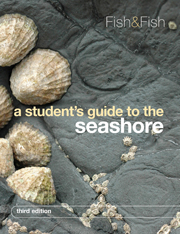Book contents
- Frontmatter
- Contents
- Preface
- Acknowledgements for illustrations
- Introduction
- Design and layout of the book
- Illustrated guide to the plants and animals of the shore
- Seaweeds
- Lichens
- Anthophyta
- Porifera
- Cnidaria
- Ctenophora
- Platyhelminthes
- Nemertea
- Priapula
- Annelida
- Mollusca
- Arthropoda
- Sipuncula
- Echiura
- Bryozoa
- Phoronida
- Echinodermata
- Hemichordata
- Chordata
- Bibliography
- Glossary
- Index
- Plate section
- References
Chordata
Published online by Cambridge University Press: 05 June 2012
- Frontmatter
- Contents
- Preface
- Acknowledgements for illustrations
- Introduction
- Design and layout of the book
- Illustrated guide to the plants and animals of the shore
- Seaweeds
- Lichens
- Anthophyta
- Porifera
- Cnidaria
- Ctenophora
- Platyhelminthes
- Nemertea
- Priapula
- Annelida
- Mollusca
- Arthropoda
- Sipuncula
- Echiura
- Bryozoa
- Phoronida
- Echinodermata
- Hemichordata
- Chordata
- Bibliography
- Glossary
- Index
- Plate section
- References
Summary
The chordates include such diverse forms as the sea-squirts found attached to rocks and stones on the lower shore, and the fishes, amphibians, reptiles, birds and mammals. Although there is great diversity of structure within the phylum, chordates are united by four features present in at least some stage in the life-cycle. These are a notochord, a hollow dorsal nerve cord, pharyngeal clefts and a post-anal tail containing extensions of the nerve cord and notochord. The notochord is a dorsal, flexible rod which has a skeletal function and may persist throughout life. It is often completely or partly replaced by cartilaginous or bony material to form a backbone. The nerve cord is dorsal to the notochord and often expanded anteriorly to form a brain, but in some groups, such as the sea-squirts, it is, like the notochord, lost in the adult. The pharyngeal clefts (sometimes known as gill slits), lead from the cavity of the pharynx to the exterior and have a variety of functions: in aquatic chordates they may be used in both feeding and respiration, but are generally reduced or lost in the adult terrestrial chordate. The post-anal tail persists in many aquatic vertebrates such as the fishes as a muscular, flexible structure which is important in locomotion.
- Type
- Chapter
- Information
- A Student's Guide to the Seashore , pp. 429 - 474Publisher: Cambridge University PressPrint publication year: 2011



